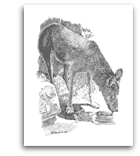GRAY
WOLF
#GWF-500
Notecards Only
Also available in Notecard Assortment Packs #AST-504
The
gray wolf, also known as the timber wolf, is the largest member
of the canine family. Once common throughout North America and
Eurasia, wolves were poisoned or hunted to near extinction. Sizable
wolf populations are now found only in Alaska, Minnesota, Canada
and parts of Europe and Asia. Small numbers of wolves live in
Washington, Idaho, Montana, Wyoming, the Dakotas, Michigan, and
Wisconsin. Wolves inhabit remote northern forests and arctic tundra
regions where prey populations are plentiful and humans are scarce.
With
a few exceptions, wolves live in groups called packs. A pack consists
of a dominant pair, their current offspring, and other non-breeding
adults. In May or June the dominant female bears a litter of four
to six pups in an underground den. When the pups are small, other
pack members bring food to the mother. As the pups get bigger,
pack members take turns bringing them food, playing with them
and even “babysitting” when the mother herself goes
hunting.
At
about two months of age, the pups emerge from their den. The adults
then move them to a meadow or open area known as a “rendezvous
site” that is near dense forest or other cover. The young
are left there, sometimes with a subordinate adult, when adults
go off together to hunt. All members of the pack cooperate in
feeding, protecting, and training the pups.
Pack
members form strong social bonds and have a structured dominance
rank. Dominance rank order changes as wolves age or get injured
and younger wolves mature and gain strength, confidence, and understanding.
Mature young wolves often leave to form their own packs.
Wolves
communicate with each other using body language, facial gestures,
scent marks and a complex array of vocal expressions. The best
studied wolf vocalization is the howl, which is used to call the
pack together, to locate each other, to proclaim territorial rights,
or for pure pleasure. Wolves are considered to be one of nature’s
most intelligent animals.
Text
© 1996 Dianne Harrah, Drawing © 1996 Bill Harrah.
|
Back to Top |
|
 |
RED
WOLF
#RWF-500
Notecards Only
The
red wolf of North America, now extinct in the wild, was once common
in the southeastern United States. Preferred habitat included
marshes, swampy forests and mountain forests.
In
the wild, the red wolf’s diet consisted of a variety of small
prey such as crayfish, rodents and rabbits - and, occasionally,
deer.
The
red wolf’s young are born in the spring, three or four pups
in a litter. Both parents participate in raising the offspring.
Text
© 1994 Dianne Harrah, Drawing © 1994 Bill Harrah.
|
 |
|
Copyright
Notice
Drawings Copyright © 1992-2013 Bill Harrah, Wolf Run Studio (SM), All Rights
Reserved. Wolf Run Studio is a service mark of Bill Harrah and has been in continuous
use since 1992. All of the images on this website are in tangible form and are
fully copyrighted. Each has an invisible digital identification which is traceable
through the Digimarc Corporation. Viewers of the Wolf Run Studio website are
allowed to browse and print out images for personal, non-commercial use only.
You may not distribute copies of images or image files to anyone else for any
reason. Images may not be reproduced or used in any form or any manner, or displayed
on any website without the express written consent of Bill
Harrah.
Text Copyright
© 1992-2013
Terry White or
Dianne Harrah. Text on this website is used with permission from the authors.
Viewers of the Wolf Run Studio website are allowed to browse and print out text
for personal, non-commercial use only. Text may not be reproduced or used in any
form or any manner without the express written consent of the authors.
Information
Accuracy
The information for the written description of each animal has been carefully
researched by the authors and is believed to be accurate. New scientific observations,
however, could make some information out-of-date. If you are a professional
zoologist, and have new information that you are willing to share, please contact
Dianne Harrah .
|



